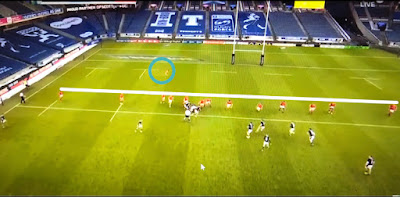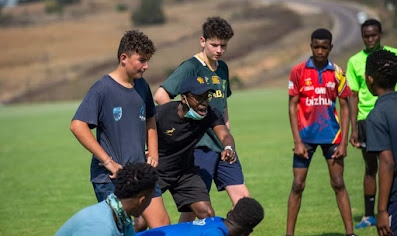Defence in the Six Nations: Focusing on Wales
Wales Defence 2021 Six Nations
Wales have struggled to get going since Wayne Pivac took over at the start of 2020, losing most of their games in last year’s Six Nations and finishing second last only because of their win against Italy. Sometimes when new coaching management takes over it can take some time to implement systems and get players to buy in from the beginning. From what we have seen in this year’s Six Nations, Wales has improved immensely and sit second on the table with equal points after two rounds, having beaten Ireland and Scotland. We can analyse their defence but should also bear in mind the impact that Wales playing against 14 men may have had on their results.
Tackle System and defence breakdown
Wales use a double hit
system. One defender goes low on the legs to stop that momentum and the next
defender will go on the ball either to choke and soak or to rip the ball out. You
will also see that they have 1 defender putting pressure on the defence
breakdown either to slow the opposition ruck ball down or to compete. If they
lose the tackle contest, they leave the breakdown alone to fold and cover their
frontline with width.
Below is a link to a
clip showing how they utilise their double hits:
In the next clip you
will see Gareth Davies first trying to choke and then in the next phase Wales
competes on the ground and force a penalty in their red zone to stop the Scotland
attack.
In this clip you will
see how they rip the ball in contact - something that they also used to do a
lot under Shaun Edwards.
Linespeed and field distribution
Wales use a 14+1 field
distribution, which means that they have 14 defenders in the front line and 1
in the backfield. This field distribution leaves you vulnerable in your
backfield as either your wingers or fullback have to work incredibly hard to
cover backfield space. We all saw how Scotland attacked Wales’ backfield space
using their 9 and 10 to score or create try scoring opportunities. Wales are
using this field distribution because they want numbers in the line which will
also help with controlling their linespeed. What they gain in a strong frontline they may lose in a vulnerable backfield. There are always pros and cons. Also, not something that’s new, but
Wales also use their 9 in the frontline. Them leaving 1 at the back defence also
shows trust from a coach - they trust
their players to cover space and apply the work rate needed to cover their back
field. There are other ways in which teams can cover the field like the 13+2 split which is used often by a lot of teams where you have 13 players in the frontline and 2 in the back field which allows for security at the back where those 2 players can cover kicks compared to Wales 1 in the backfield. This is the perfect example that there are so many ways to attack and defend but you need to use what will work for you and sell it to your players as coach!
Below is an example of Wales 14+1 field
distribution against Scotland
Below is an
example of Wales 14+1 field distribution against Ireland
Below is an
example of Wales 14+1 field distribution against Ireland
Wales get off the line
and look to apply pressure. In the clip below you will see how they get their
width right by folding well, how they get off the line by using line speed and
how they get into their double hit system. Their organisation is evident in the
way that they defend. Wales are also very patient and can defend for multiple phases until the attack makes a mistake or if they spot an opportunity on the ground.
The following stats on ESPN https://africa.espn.com/rugby/ provide an idea of Welsh players who have made the most tackles in the first two games:
|
|
Vs Ireland |
|
Vs Scotland |
|
Justin Tupuric |
29 Tackles |
Tualape Faletau |
19 Tackles |
|
Alan Wyn Jones |
23 Tackles |
Wyn Jones |
14 Tackles |
|
Josh Navidi |
22 Tackles |
Alan Wyn Jones |
13 Tackles |
|
Wale |
France |
England |
Scotland |
Ireland |
Italy |
|
Tackles |
Tackles |
Tackles |
Tackles |
Tackles |
Tackles |
|
355/398 |
338/381 |
262/303 |
196/213 |
217/259 |
271/330 |
|
89% |
89% |
86% |
92% |
84% |
82% |
Tries Conceded
|
Wales |
France |
England |
|
4 |
2 |
3 |
|
Scotland |
Ireland |
Italy |
|
3 |
2 |
13 |
Wales have worked hard on their defence in the last few months and it shows in their system and how hard they work for each other. Their set piece has been very good, and they have been taking opportunities given to them. This is evident in that their possession was only 36% against Ireland and their territory only 32%. They also beat Scotland with 38% possession and 35% territory. That shows that you do not need possession and territory as much as what people say you do, but rather what is important is how you use your possession and what you do with it when you have it.
Is it premature to start talking about Wales winning this year’s Six Nations and what that will do for Wayne Pivac with Wales in the future? Three more rounds to go!
Katleho Lynch (SA Schools Coach, Director of Rugby, Varsity Cup Coach)






Comments
Post a Comment